#hamza el boudali
Explore tagged Tumblr posts
Text



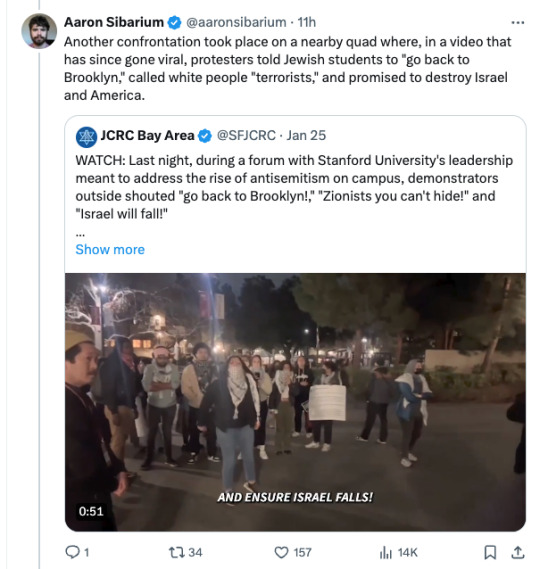
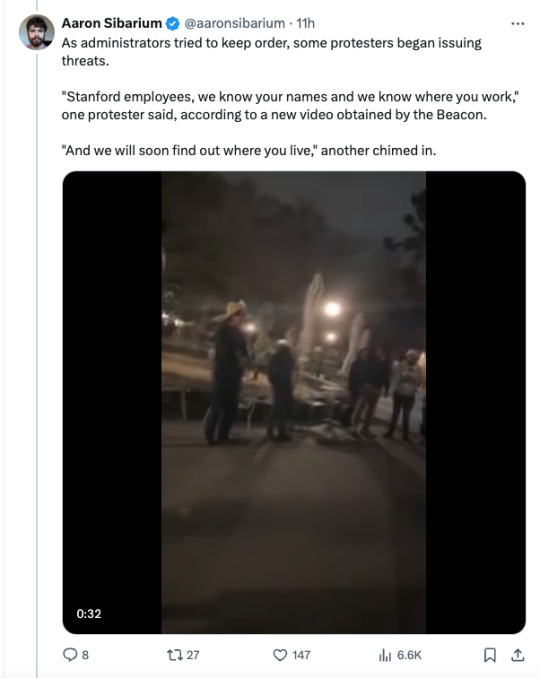

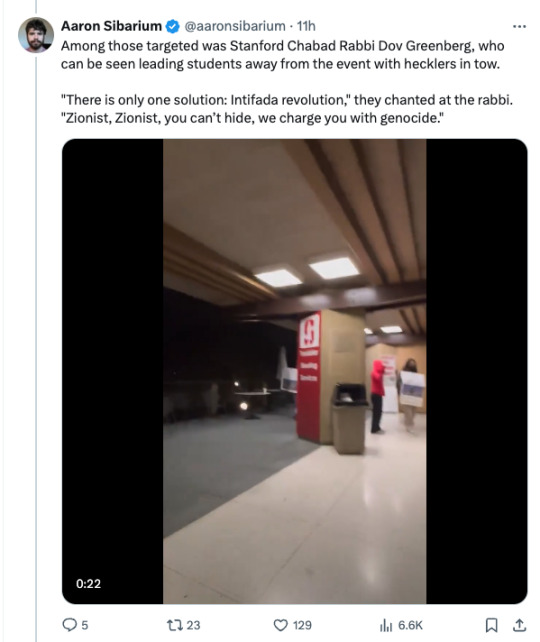

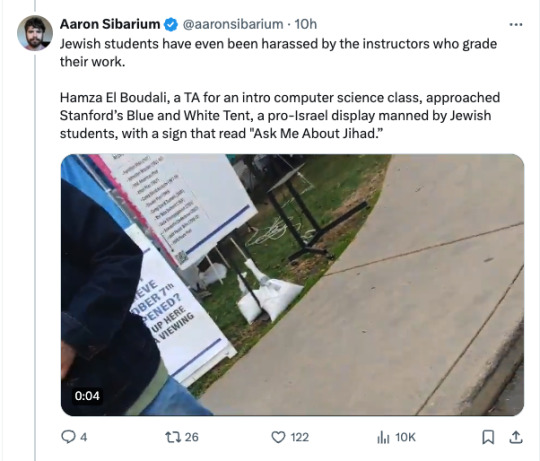
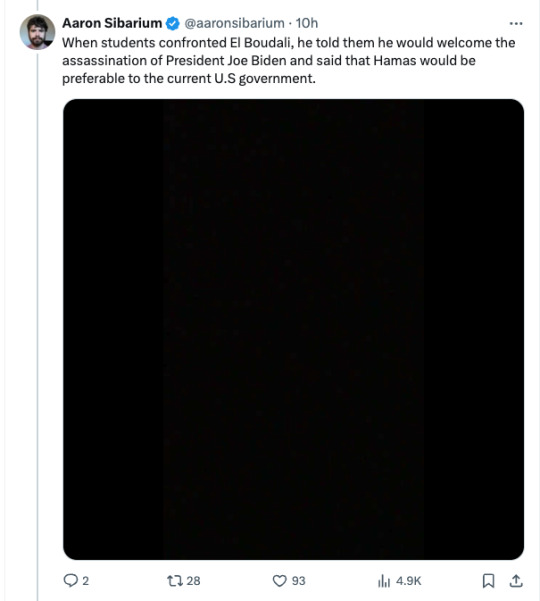

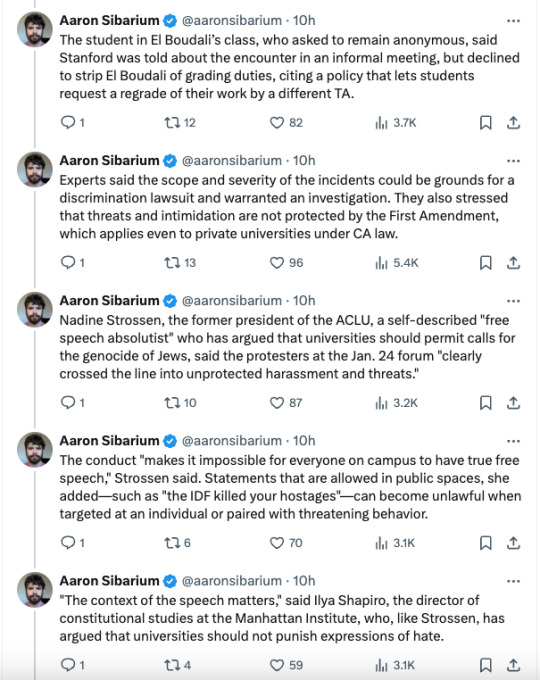

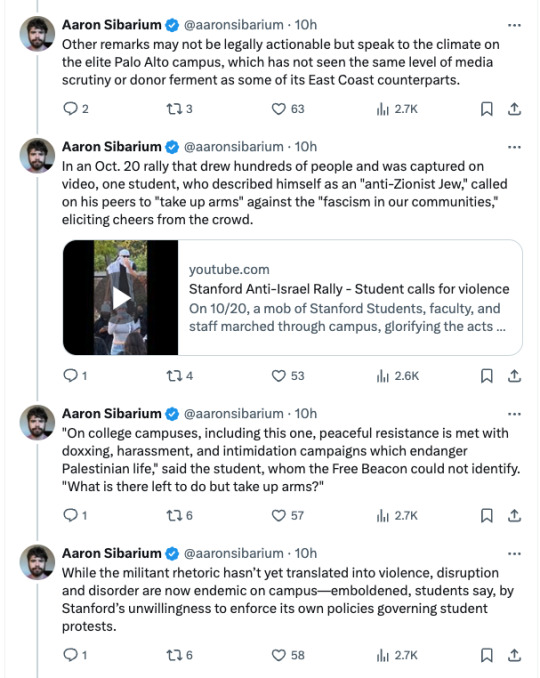

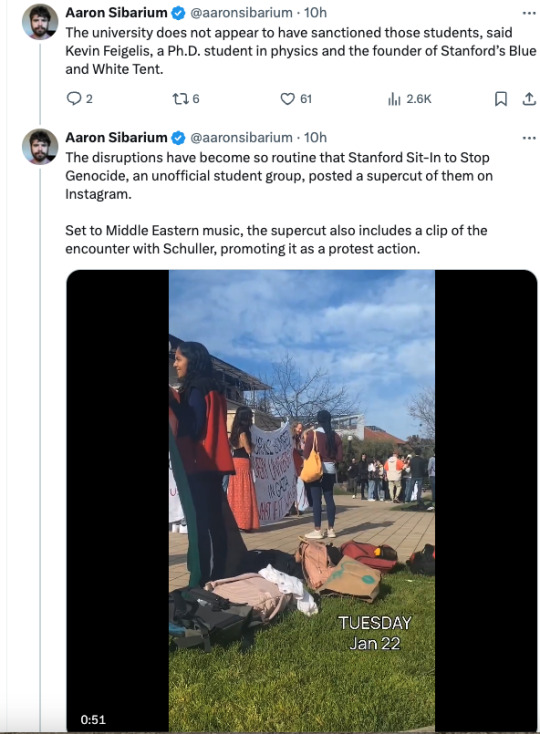


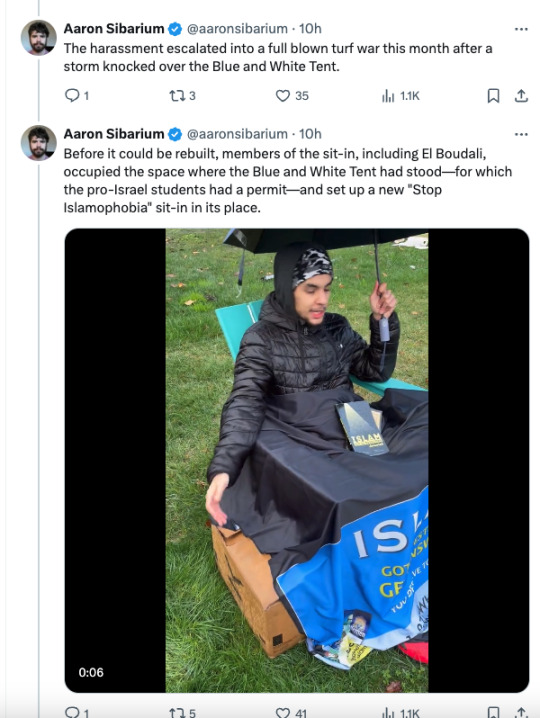
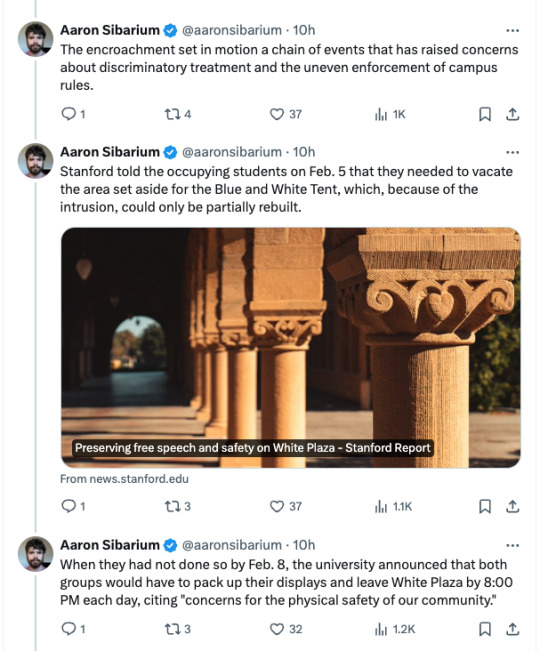

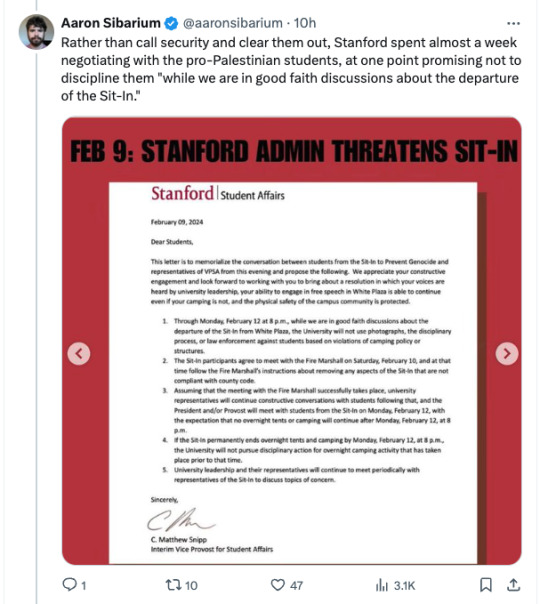



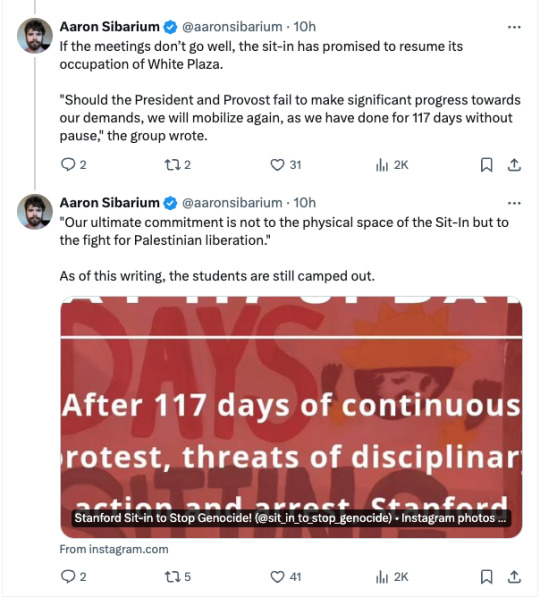
Source
The article this X thread was created from is at the Washington Free Beacon.
#stanford university#the mob#antisemitism#jewish students#camping on campus#hamza el boudali#ari kelman#david schuller#harassment
503 notes
·
View notes
Text
One of the section leaders for my computer-science class, Hamza El Boudali, believes that President Joe Biden should be killed. “I’m not calling for a civilian to do it, but I think a military should,” the 23-year-old Stanford University student told a small group of protesters last month. “I’d be happy if Biden was dead.” He thinks that Stanford is complicit in what he calls the genocide of Palestinians, and that Biden is not only complicit but responsible for it. “I’m not calling for a vigilante to do it,” he later clarified, “but I’m saying he is guilty of mass murder and should be treated in the same way that a terrorist with darker skin would be (and we all know terrorists with dark skin are typically bombed and drone striked by American planes).” El Boudali has also said that he believes that Hamas’s October 7 attack was a justifiable act of resistance, and that he would actually prefer Hamas rule America in place of its current government (though he clarified later that he “doesn’t mean Hamas is perfect”). When you ask him what his cause is, he answers: “Peace.”
I switched to a different computer-science section.
Israel is 7,500 miles away from Stanford’s campus, where I am a sophomore. But the Hamas invasion and the Israeli counterinvasion have fractured my university, a place typically less focused on geopolitics than on venture-capital funding for the latest dorm-based tech start-up. Few students would call for Biden’s head—I think—but many of the same young people who say they want peace in Gaza don’t seem to realize that they are in fact advocating for violence. Extremism has swept through classrooms and dorms, and it is becoming normal for students to be harassed and intimidated for their faith, heritage, or appearance—they have been called perpetrators of genocide for wearing kippahs, and accused of supporting terrorism for wearing keffiyehs. The extremism and anti-Semitism at Ivy League universities on the East Coast have attracted so much media and congressional attention that two Ivy presidents have lost their jobs. But few people seem to have noticed the culture war that has taken over our California campus.
For four months, two rival groups of protesters, separated by a narrow bike path, faced off on Stanford’s palm-covered grounds. The “Sit-In to Stop Genocide” encampment was erected by students in mid-October, even before Israeli troops had crossed into Gaza, to demand that the university divest from Israel and condemn its behavior. Posters were hung equating Hamas with Ukraine and Nelson Mandela. Across from the sit-in, a rival group of pro-Israel students eventually set up the “Blue and White Tent” to provide, as one activist put it, a “safe space” to “be a proud Jew on campus.” Soon it became the center of its own cluster of tents, with photos of Hamas’s victims sitting opposite the rubble-ridden images of Gaza and a long (and incomplete) list of the names of slain Palestinians displayed by the students at the sit-in.
Some days the dueling encampments would host only a few people each, but on a sunny weekday afternoon, there could be dozens. Most of the time, the groups tolerated each other. But not always. Students on both sides were reportedly spit on and yelled at, and had their belongings destroyed. (The perpetrators in many cases seemed to be adults who weren’t affiliated with Stanford, a security guard told me.) The university put in place round-the-clock security, but when something actually happened, no one quite knew what to do.
Stanford has a policy barring overnight camping, but for months didn’t enforce it, “out of a desire to support the peaceful expression of free speech in the ways that students choose to exercise that expression”—and, the administration told alumni, because the university feared that confronting the students would only make the conflict worse. When the school finally said the tents had to go last month, enormous protests against the university administration, and against Israel, followed.
“We don’t want no two states! We want all of ’48!” students chanted, a slogan advocating that Israel be dismantled and replaced by a single Arab nation. Palestinian flags flew alongside bright “Welcome!” banners left over from new-student orientation. A young woman gave a speech that seemed to capture the sense of urgency and power that so many students here feel. “We are Stanford University!” she shouted. “We control things!”
“We’ve had protests in the past,” Richard Saller, the university’s interim president, told me in November—about the environment, and apartheid, and Vietnam. But they didn’t pit “students against each other” the way that this conflict has.
I’ve spoken with Saller, a scholar of Roman history, a few times over the past six months in my capacity as a student journalist. We first met in September, a few weeks into his tenure. His predecessor, Marc Tessier-Lavigne, had resigned as president after my reporting for The Stanford Daily exposed misconduct in his academic research. (Tessier-Lavigne had failed to retract papers with faked data over the course of 20 years. In his resignation statement, he denied allegations of fraud and misconduct; a Stanford investigation determined that he had not personally manipulated data or ordered any manipulation but that he had repeatedly “failed to decisively and forthrightly correct mistakes” from his lab.)
In that first conversation, Saller told me that everyone was “eager to move on” from the Tessier-Lavigne scandal. He was cheerful and upbeat. He knew he wasn’t staying in the job long; he hadn’t even bothered to move into the recently vacated presidential manor. In any case, campus, at that time, was serene. Then, a week later, came October 7.
The attack was as clear a litmus test as one could imagine for the Middle East conflict. Hamas insurgents raided homes and a music festival with the goal of slaughtering as many civilians as possible. Some victims were raped and mutilated, several independent investigations found. Hundreds of hostages were taken into Gaza and many have been tortured.
This, of course, was bad. Saying this was bad does not negate or marginalize the abuses and suffering Palestinians have experienced in Gaza and elsewhere. Everyone, of every ideology, should be able to say that this was bad. But much of this campus failed that simple test.
Two days after the deadliest massacre of Jews since the Holocaust, Stanford released milquetoast statements marking the “moment of intense emotion” and declaring “deep concern” over “the crisis in Israel and Palestine.” The official statements did not use the words Hamas or violence.
The absence of a clear institutional response led some teachers to take matters into their own hands. During a mandatory freshman seminar on October 10, a lecturer named Ameer Loggins tossed out his lesson plan to tell students that the actions of the Palestinian “military force” had been justified, that Israelis were colonizers, and that the Holocaust had been overemphasized, according to interviews I conducted with students in the class. Loggins then asked the Jewish students to identify themselves. He instructed one of them to “stand up, face the window, and he kind of kicked away his chair,” a witness told me. Loggins described this as an effort to demonstrate Israel’s treatment of Palestinians. (Loggins did not reply to a request for comment; a spokesperson for Stanford said that there were “different recollections of the details regarding what happened” in the class.)
“We’re only in our third week of college, and we’re afraid to be here,” three students in the class wrote in an email that night to administrators. “This isn’t what Stanford was supposed to be.” The class Loggins taught is called COLLEGE, short for “Civic, Liberal, and Global Education,” and it is billed as an effort to develop “the skills that empower and enable us to live together.”
Loggins was suspended from teaching duties and an investigation was opened; this angered pro-Palestine activists, who organized a petition that garnered more than 1,700 signatures contesting the suspension. A pamphlet from the petitioners argued that Loggins’s behavior had not been out of bounds.
The day after the class, Stanford put out a statement written by Saller and Jenny Martinez, the university provost, more forcefully condemning the Hamas attack. Immediately, this new statement generated backlash.
Pro-Palestine activists complained about it during an event held the same day, the first of several “teach-ins” about the conflict. Students gathered in one of Stanford’s dorms to “bear witness to the struggles of decolonization.” The grievances and pain shared by Palestinian students were real. They told of discrimination and violence, of frightened family members subjected to harsh conditions. But the most raucous reaction from the crowd was in response to a young woman who said, “You ask us, do we condemn Hamas? Fuck you!” She added that she was “so proud of my resistance.”
David Palumbo-Liu, a professor of comparative literature with a focus on postcolonial studies, also spoke at the teach-in, explaining to the crowd that “European settlers” had come to “replace” Palestine’s “native population.”
Palumbo-Liu is known as an intelligent and supportive professor, and is popular among students, who call him by his initials, DPL. I wanted to ask him about his involvement in the teach-in, so we met one day in a café a few hundred feet away from the tents. I asked if he could elaborate on what he’d said at the event about Palestine’s native population. He was happy to expand: This was “one of those discussions that could go on forever. Like, who is actually native? At what point does nativism lapse, right? Well, you haven’t been native for X number of years, so …” In the end, he said, “you have two people who both feel they have a claim to the land,” and “they have to live together. Both sides have to cede something.”
The struggle at Stanford, he told me, “is to find a way in which open discussions can be had that allow people to disagree.” It’s true that Stanford has utterly failed in its efforts to encourage productive dialogue. But I still found it hard to reconcile DPL’s words with his public statements on Israel, which he’d recently said on Facebook should be “the most hated nation in the world.” He also wrote: “When Zionists say they don’t feel ‘safe’ on campus, I’ve come to see that as they no longer feel immune to criticism of Israel.” He continued: “Well as the saying goes, get used to it.”
Zionists, and indeed Jewish students of all political beliefs, have been given good reason to fear for their safety. They’ve been followed, harassed, and called derogatory racial epithets. At least one was told he was a “dirty Jew.” At least twice, mezuzahs have been ripped from students’ doors, and swastikas have been drawn in dorms. Arab and Muslim students also face alarming threats. The computer-science section leader, El Boudali, a pro-Palestine activist, told me he felt “safe personally,” but knew others who did not: “Some people have reported feeling like they’re followed, especially women who wear the hijab.”
In a remarkably short period of time, aggression and abuse have become commonplace, an accepted part of campus activism. In January, Jewish students organized an event dedicated to ameliorating anti-Semitism. It marked one of Saller’s first public appearances in the new year. Its topic seemed uncontroversial, and I thought it would generate little backlash.
Protests began before the panel discussion even started, with activists lining the stairs leading to the auditorium. During the event they drowned out the panelists, one of whom was Israel’s special envoy for combating anti-Semitism, by demanding a cease-fire. After participants began cycling out into the dark, things got ugly.
Activists, their faces covered by keffiyehs or medical masks, confronted attendees. “Go back to Brooklyn!” a young woman shouted at Jewish students. One protester, who emerged as the leader of the group, said that she and her compatriots would “take all of your places and ensure Israel falls.” She told attendees to get “off our fucking campus” and launched into conspiracy theories about Jews being involved in “child trafficking.” As a rabbi tried to leave the event, protesters pursued him, chanting, “There is only one solution! Intifada revolution!”
At one point, some members of the group turned on a few Stanford employees, including another rabbi, an imam, and a chaplain, telling them, “We know your names and we know where you work.” The ringleader added: “And we’ll soon find out where you live.” The religious leaders formed a protective barrier in front of the Jewish students. The rabbi and the imam appeared to be crying.
Saller avoided the protest by leaving through another door. Early that morning, his private residence had been vandalized. Protesters frequently tell him he “can’t hide” and shout him down. “We charge you with genocide!” they chant, demanding that Stanford divest from Israel. (When asked whether Stanford actually invested in Israel, a spokesperson replied that, beyond small exposures from passive funds that track indexes such as the S&P 500, the university’s endowment “has no direct holdings in Israeli companies, or direct holdings in defense contractors.”)
When the university finally said the protest tents had to be removed, students responded by accusing Saller of suppressing their right to free speech. This is probably the last charge he expected to face. Saller once served as provost at the University of Chicago, which is known for holding itself to a position of strict institutional neutrality so that its students can freely explore ideas for themselves. Saller has a lifelong belief in First Amendment rights. But that conviction in impartial college governance does not align with Stanford’s behavior in recent years. Despite the fact that many students seemed largely uninterested in the headlines before this year, Stanford’s administrative leadership has often taken positions on political issues and events, such as the Paris climate conference and the murder of George Floyd. After Russia invaded Ukraine, Stanford’s Hoover Tower was lit up in blue and yellow, and the school released a statement in solidarity.
When we first met, a week before October 7, I asked Saller about this. Did Stanford have a moral duty to denounce the war in Ukraine, for example, or the ethnic cleansing of Uyghur Muslims in China? “On international political issues, no,” he said. “That’s not a responsibility for the university as a whole, as an institution.”
But when Saller tried to apply his convictions on neutrality for the first time as president, dozens of faculty members condemned the response, many pro-Israel alumni were outraged, donors had private discussions about pulling funding, and an Israeli university sent an open letter to Saller and Martinez saying, “Stanford’s administration has failed us.” The initial statement had tried to make clear that the school’s policy was not Israel-specific: It noted that the university would not take a position on the turmoil in Nagorno-Karabakh (where Armenians are undergoing ethnic cleansing) either. But the message didn’t get through.
Saller had to beat an awkward retreat or risk the exact sort of public humiliation that he, as caretaker president, had presumably been hired to avoid. He came up with a compromise that landed somewhere in the middle: an unequivocal condemnation of Hamas’s “intolerable atrocities” paired with a statement making clear that Stanford would commit to institutional neutrality going forward.
“The events in Israel and Gaza this week have affected and engaged large numbers of students on our campus in ways that many other events have not,” the statement read. “This is why we feel compelled to both address the impact of these events on our campus and to explain why our general policy of not issuing statements about news events not directly connected to campus has limited the breadth of our comments thus far, and why you should not expect frequent commentary from us in the future.”
I asked Saller why he had changed tack on Israel and not on Nagorno-Karabakh. “We don’t feel as if we should be making statements on every war crime and atrocity,” he told me. This felt like a statement in and of itself.
In making such decisions, Saller works closely with Martinez, Stanford’s provost. I happened to interview her, too, a few days before October 7, not long after she’d been appointed. When I asked about her hopes for the job, she said that a “priority is ensuring an environment in which free speech and academic freedom are preserved.”
We talked about the so-called Leonard Law—a provision unique to California that requires private universities to be governed by the same First Amendment protections as public ones. This restricts what Stanford can do in terms of penalizing speech, putting it in a stricter bind than Harvard, the University of Pennsylvania, or any of the other elite private institutions that have more latitude to set the standards for their campus (whether or not they have done so).
So I was surprised when, in December, the university announced that abstract calls for genocide “clearly violate Stanford’s Fundamental Standard, the code of conduct for all students at the university.” The statement was a response to the outrage following the congressional testimony of three university presidents—outrage that eventually led to the resignation of two of them, Harvard’s Claudine Gay and Penn’s Liz Magill. Gay and Magill, who had both previously held positions at Stanford, did not commit to punishing calls for the genocide of Jews.
Experts told me that Stanford’s policy is impossible to enforce—and Saller himself acknowledged as much in our March interview.
“Liz Magill is a good friend,” Saller told me, adding, “Having watched what happened at Harvard and Penn, it seemed prudent” to publicly state that Stanford rejected calls for genocide. But saying that those calls violate the code of conduct “is not the same thing as to say that we could actually punish it.”
Stanford’s leaders seem to be trying their best while adapting to the situation in real time. But the muddled messaging has created a policy of neutrality that does not feel neutral at all.
When we met back in November, I tried to get Saller to open up about his experience running an institution in turmoil. What’s it like to know that so many students seem to believe that he—a mild-mannered 71-year-old classicist who swing-dances with his anthropologist wife—is a warmonger? Saller was more candid than I expected—perhaps more candid than any prominent university president has been yet. We sat in the same conference room as we had in September. The weather hadn’t really changed. Yet I felt like I was sitting in front of a different person. He was hunched over and looked exhausted, and his voice broke when he talked about the loss of life in Gaza and Israel and “the fact that we’re caught up in it.” A capable administrator with decades of experience, Saller seemed almost at a loss. “It’s been a kind of roller coaster, to be honest.”
He said he hadn’t anticipated the deluge of the emails “blaming me for lack of moral courage.” Anything the university says seems bound to be wrong: “If I say that our position is that we grieve over the loss of innocent lives, that in itself will draw some hostile reactions.”
“I find that really difficult to navigate,” he said with a sigh.
By March, it seemed that his views had solidified. He said he knew he was “a target,” but he was not going to be pushed into issuing any more statements. The continuing crisis seems to have granted him new insight. “I am certain that whatever I say will not have any material effect on the war in Gaza.” It’s hard to argue with that.
People tend to blame the campus wars on two villains: dithering administrators and radical student activists. But colleges have always had dithering administrators and radical student activists. To my mind, it’s the average students who have changed.
Elite universities attract a certain kind of student: the overachieving striver who has won all the right accolades for all the right activities. Is it such a surprise that the kids who are trained in the constant pursuit of perfect scores think they have to look at the world like a series of multiple-choice questions, with clearly right or wrong answers? Or that they think they can gamify a political cause in the same way they ace a standardized test?
Everyone knows that the only reliable way to get into a school like Stanford is to be really good at looking really good. Now that they’re here, students know that one easy way to keep looking good is to side with the majority of protesters, and condemn Israel.
It’s not that there isn’t real anger and anxiety over what is happening in Gaza—there is, and justifiably so. I know that among the protesters are many people who are deeply connected to this issue. But they are not the majority. What really activates the crowds now seems less a principled devotion to Palestine or to pacifism than a desire for collective action, to fit in by embracing the fashionable cause of the moment—as if a centuries-old conflict in which both sides have stolen and killed could ever be a simple matter of right and wrong. In their haste to exhibit moral righteousness, many of the least informed protesters end up being the loudest and most uncompromising.
Today’s students grew up in the Trump era, in which violent rhetoric has become a normal part of political discourse and activism is as easy as reposting an infographic. Many young people have come to feel that being angry is enough to foment change. Furious at the world’s injustices and desperate for a simple way to express that fury, they don’t seem interested in any form of engagement more nuanced than backing a pure protagonist and denouncing an evil enemy. They don’t, always, seem that concerned with the truth.
At the protest last month to prevent the removal of the sit-in, an activist in a pink Women’s March “pussy hat” shouted that no rape was committed by Hamas on October 7. “There hasn’t been proof of these rape accusations,” a student told me in a separate conversation, criticizing the Blue and White Tent for spreading what he considered to be misinformation about sexual violence. (In March, a United Nations report found “reasonable grounds to believe that conflict-related sexual violence,” including “rape and gang rape,” occurred in multiple locations on October 7, as well as “clear and convincing information” on the “rape and sexualized torture” of hostages.) “The level of propaganda” surrounding Hamas, he told me, “is just unbelievable.”
The real story at Stanford is not about the malicious actors who endorse sexual assault and murder as forms of resistance, but about those who passively enable them because they believe their side can do no wrong. You don’t have to understand what you’re arguing for in order to argue for it. You don’t have to be able to name the river or the sea under discussion to chant “From the river to the sea.” This kind of obliviousness explains how one of my friends, a gay activist, can justify Hamas’s actions, even though it would have the two of us—an outspoken queer person and a Jewish reporter—killed in a heartbeat. A similar mentality can exist on the other side: I have heard students insist on the absolute righteousness of Israel yet seem uninterested in learning anything about what life is like in Gaza.
I’m familiar with the pull of achievement culture—after all, I’m a product of the same system. I fell in love with Stanford as a 7-year-old, lying on the floor of an East Coast library and picturing all the cool technology those West Coast geniuses were dreaming up. I cried when I was accepted; I spent the next few months scrolling through the course catalog, giddy with anticipation. I wanted to learn everything.
I learned more than I expected. Within my first week here, someone asked me: “Why are all Jews so rich?” In 2016, when Stanford’s undergraduate senate had debated a resolution against anti-Semitism, one of its members argued that the idea of “Jews controlling the media, economy, government, and other societal institutions” represented “a very valid discussion.” (He apologized, and the resolution passed.) In my dorm last year, a student discussed being Jewish and awoke the next day to swastikas and a portrait of Hitler affixed to his door.
I grew up secularly, with no strong affiliation to Jewish culture. When I found out as a teenager that some of my ancestors had hidden their identity from their children and that dozens of my relatives had died in the Holocaust (something no living member of my family had known), I felt the barest tremor of identity. After I saw so many people I know cheering after October 7, I felt something stronger stir. I know others have experienced something similar. Even a professor texted me to say that she felt Jewish in a way she never had before.
But my frustration with the conflict on campus has little to do with my own identity. Across the many conversations and hours of formal interviews I conducted for this article, I’ve encountered a persistent anti-intellectual streak. I’ve watched many of my classmates treat death so cavalierly that they can protest as a pregame to a party. Indeed, two parties at Stanford were reported to the university this fall for allegedly making people say “Fuck Israel” or “Free Palestine” to get in the door. A spokesperson for the university said it was “unable to confirm the facts of what occurred,” but that it had “met with students involved in both parties to make clear that Stanford’s nondiscrimination policy applies to parties.” As a friend emailed me not long ago: “A place that was supposed to be a sanctuary from such unreason has become a factory for it.”
Readers may be tempted to discount the conduct displayed at Stanford. After all, the thinking goes, these are privileged kids doing what they always do: embracing faux-radicalism in college before taking jobs in fintech or consulting. These students, some might say, aren’t representative of America.
And yet they are representative of something: of the conduct many of the most accomplished students in my generation have accepted as tolerable, and what that means for the future of our country. I admire activism. We need people willing to protest what they see as wrong and take on entrenched systems of repression. But we also need to read, learn, discuss, accept the existence of nuance, embrace diversity of thought, and hold our own allies to high standards. More than ever, we need universities to teach young people how to do all of this.
For so long, Stanford’s physical standoff seemed intractable. Then, in early February, a storm swept in, and the natural world dictated its own conclusion.
Heavy rains flooded campus. For hours, the students battled to save their tents. The sit-in activists used sandbags and anything else they could find to hold back the water—at one point, David Palumbo-Liu, the professor, told me he stood in the lashing downpour to anchor one of the sit-in’s tents with his own body. When the storm hit, many of the Jewish activists had been attending a discussion on anti-Semitism. They raced back and struggled to salvage the Blue and White Tent, but it was too late—the wind had ripped it out of the ground.
The next day, the weary Jewish protesters returned to discover that their space had been taken.
A new collection of tents had been set up by El Boudali, the pro-Palestine activist, and a dozen friends. He said they were there to protest Islamophobia and to teach about Islam and jihad, and that they were a separate entity from the Sit-In to Stop Genocide, though I observed students cycling between the tents. Palestinian flags now flew from the bookstore to the quad.
Administrators told me they’d quickly informed El Boudali and his allies that the space had been reserved by the Jewish advocates, and offered to help move them to a different location. But the protesters told me they had no intention of going. (El Boudali later said that they did not take over the entire space, and would have been “happy to exist side by side, but they wanted to kick us off entirely from that lawn.”)
When it was clear that the area where they’d set up their tents would not be ceded back to the pro-Israel group willingly, Stanford changed course and decided to clear everyone out in one fell swoop. On February 8, school officials ordered all students to vacate the plaza overnight. The university was finally going to enforce its rule prohibiting people from sleeping outside on campus and requiring the removal of belongings from the plaza between 8 p.m. and 8 a.m. The order cited the danger posed by the storm as a justification for changing course and, probably hoping to avoid allegations of bias, described the decision as “viewpoint-neutral.”
That didn’t work.
About a week of protests, led by the sit-in organizers, followed. Chants were chanted. More demands for a “river to the sea” solution to the Israel problem were made. A friend boasted to me about her willingness to be arrested. Stanford sent a handful of staff members, who stood near balloons left over from an event earlier in the day. They were there, one of them told me, to “make students feel supported and safe.”
In the end, Saller and Martinez agreed to talk with the leaders of the sit-in about their demands to divest the university and condemn Israel, under the proviso that the activists comply with Stanford’s anti-camping guidelines “regardless of the outcome of discussions.” Eight days after they were first instructed to leave, 120 days after setting up camp, the sit-in protesters slept in their own beds. In defiance of the university’s instructions, they left behind their tents. But sometime in the very early hours of the morning, law-enforcement officers confiscated the structures. The area was cordoned off without any violence and the plaza filled once more with electric skateboards and farmers’ markets.
The conflict continues in its own way. Saller was just shouted down by protesters chanting “No peace on stolen land” at a Family Weekend event, and protesters later displayed an effigy of him covered in blood. Students still feel tense; Saller still seems worried. He told me that the university is planning to change all manner of things—residential-assistant training, new-student orientation, even the acceptance letters that students receive—in hopes of fostering a culture of greater tolerance. But no campus edict or panel discussion can address a problem that is so much bigger than our university.
At one rally last fall, a speaker expressed disillusionment about the power of “peaceful resistance” on college campuses. “What is there left to do but to take up arms?” The crowd cheered as he said Israel must be destroyed. But what would happen to its citizens? I’d prefer to believe that most protesters chanting “Palestine is Arab” and shouting that we must “smash the Zionist settler state” don’t actually think Jews should be killed en masse. But can one truly be so ignorant as to advocate widespread violence in the name of peace?
When the world is rendered in black-and-white—portrayed as a simple fight between colonizer and colonized—the answer is yes. Solutions, by this logic, are absolute: Israel or Palestine, nothing in between. Either you support liberation of the oppressed or you support genocide. Either Stanford is all good or all bad; all in favor of free speech or all authoritarian; all anti-Semitic or all Islamophobic.
At January’s anti-anti-Semitism event, I watched an exchange between a Jewish attendee and a protester from a few feet away. “Are you pro-Palestine?” the protester asked.
“Yes,” the attendee responded, and he went on to describe his disgust with the human-rights abuses Palestinians have faced for years.
“But are you a Zionist?”
“Yes.”
“Then we are enemies.”
48 notes
·
View notes
Text
By: Theo Baker
Published: Mar 26, 2024
One of the section leaders for my computer-science class, Hamza El Boudali, believes that President Joe Biden should be killed. “I’m not calling for a civilian to do it, but I think a military should,” the 23-year-old Stanford University student told a small group of protesters last month. “I’d be happy if Biden was dead.” He thinks that Stanford is complicit in what he calls the genocide of Palestinians, and that Biden is not only complicit but responsible for it. “I’m not calling for a vigilante to do it,” he later clarified, “but I’m saying he is guilty of mass murder and should be treated in the same way that a terrorist with darker skin would be (and we all know terrorists with dark skin are typically bombed and drone striked by American planes).” El Boudali has also said that he believes that Hamas’s October 7 attack was a justifiable act of resistance, and that he would actually prefer Hamas rule America in place of its current government (though he clarified later that he “doesn’t mean Hamas is perfect”). When you ask him what his cause is, he answers: “Peace.”
I switched to a different computer-science section.
Israel is 7,500 miles away from Stanford’s campus, where I am a sophomore. But the Hamas invasion and the Israeli counterinvasion have fractured my university, a place typically less focused on geopolitics than on venture-capital funding for the latest dorm-based tech start-up. Few students would call for Biden’s head—I think—but many of the same young people who say they want peace in Gaza don’t seem to realize that they are in fact advocating for violence. Extremism has swept through classrooms and dorms, and it is becoming normal for students to be harassed and intimidated for their faith, heritage, or appearance—they have been called perpetrators of genocide for wearing kippahs, and accused of supporting terrorism for wearing keffiyehs. The extremism and anti-Semitism at Ivy League universities on the East Coast have attracted so much media and congressional attention that two Ivy presidents have lost their jobs. But few people seem to have noticed the culture war that has taken over our California campus.
For four months, two rival groups of protesters, separated by a narrow bike path, faced off on Stanford’s palm-covered grounds. The “Sit-In to Stop Genocide” encampment was erected by students in mid-October, even before Israeli troops had crossed into Gaza, to demand that the university divest from Israel and condemn its behavior. Posters were hung equating Hamas with Ukraine and Nelson Mandela. Across from the sit-in, a rival group of pro-Israel students eventually set up the “Blue and White Tent” to provide, as one activist put it, a “safe space” to “be a proud Jew on campus.” Soon it became the center of its own cluster of tents, with photos of Hamas’s victims sitting opposite the rubble-ridden images of Gaza and a long (and incomplete) list of the names of slain Palestinians displayed by the students at the sit-in.
Some days the dueling encampments would host only a few people each, but on a sunny weekday afternoon, there could be dozens. Most of the time, the groups tolerated each other. But not always. Students on both sides were reportedly spit on and yelled at, and had their belongings destroyed. (The perpetrators in many cases seemed to be adults who weren’t affiliated with Stanford, a security guard told me.) The university put in place round-the-clock security, but when something actually happened, no one quite knew what to do.
Stanford has a policy barring overnight camping, but for months didn’t enforce it, “out of a desire to support the peaceful expression of free speech in the ways that students choose to exercise that expression”—and, the administration told alumni, because the university feared that confronting the students would only make the conflict worse. When the school finally said the tents had to go last month, enormous protests against the university administration, and against Israel, followed.
“We don’t want no two states! We want all of ’48!” students chanted, a slogan advocating that Israel be dismantled and replaced by a single Arab nation. Palestinian flags flew alongside bright “Welcome!” banners left over from new-student orientation. A young woman gave a speech that seemed to capture the sense of urgency and power that so many students here feel. “We are Stanford University!” she shouted. “We control things!”
“We’ve had protests in the past,” Richard Saller, the university’s interim president, told me in November—about the environment, and apartheid, and Vietnam. But they didn’t pit “students against each other” the way that this conflict has.
I’ve spoken with Saller, a scholar of Roman history, a few times over the past six months in my capacity as a student journalist. We first met in September, a few weeks into his tenure. His predecessor, Marc Tessier-Lavigne, had resigned as president after my reporting for The Stanford Daily exposed misconduct in his academic research. (Tessier-Lavigne had failed to retract papers with faked data over the course of 20 years. In his resignation statement, he denied allegations of fraud and misconduct; a Stanford investigation determined that he had not personally manipulated data or ordered any manipulation but that he had repeatedly “failed to decisively and forthrightly correct mistakes” from his lab.)
In that first conversation, Saller told me that everyone was “eager to move on” from the Tessier-Lavigne scandal. He was cheerful and upbeat. He knew he wasn’t staying in the job long; he hadn’t even bothered to move into the recently vacated presidential manor. In any case, campus, at that time, was serene. Then, a week later, came October 7.
The attack was as clear a litmus test as one could imagine for the Middle East conflict. Hamas insurgents raided homes and a music festival with the goal of slaughtering as many civilians as possible. Some victims were raped and mutilated, several independent investigations found. Hundreds of hostages were taken into Gaza and many have been tortured.
This, of course, was bad. Saying this was bad does not negate or marginalize the abuses and suffering Palestinians have experienced in Gaza and elsewhere. Everyone, of every ideology, should be able to say that this was bad. But much of this campus failed that simple test.
Two days after the deadliest massacre of Jews since the Holocaust, Stanford released milquetoast statements marking the “moment of intense emotion” and declaring “deep concern” over “the crisis in Israel and Palestine.” The official statements did not use the words Hamas or violence.
The absence of a clear institutional response led some teachers to take matters into their own hands. During a mandatory freshman seminar on October 10, a lecturer named Ameer Loggins tossed out his lesson plan to tell students that the actions of the Palestinian “military force” had been justified, that Israelis were colonizers, and that the Holocaust had been overemphasized, according to interviews I conducted with students in the class. Loggins then asked the Jewish students to identify themselves. He instructed one of them to “stand up, face the window, and he kind of kicked away his chair,” a witness told me. Loggins described this as an effort to demonstrate Israel’s treatment of Palestinians. (Loggins did not reply to a request for comment; a spokesperson for Stanford said that there were “different recollections of the details regarding what happened” in the class.)
“We’re only in our third week of college, and we’re afraid to be here,” three students in the class wrote in an email that night to administrators. “This isn’t what Stanford was supposed to be.” The class Loggins taught is called COLLEGE, short for “Civic, Liberal, and Global Education,” and it is billed as an effort to develop “the skills that empower and enable us to live together.”
Loggins was suspended from teaching duties and an investigation was opened; this angered pro-Palestine activists, who organized a petition that garnered more than 1,700 signatures contesting the suspension. A pamphlet from the petitioners argued that Loggins’s behavior had not been out of bounds.
The day after the class, Stanford put out a statement written by Saller and Jenny Martinez, the university provost, more forcefully condemning the Hamas attack. Immediately, this new statement generated backlash.
Pro-Palestine activists complained about it during an event held the same day, the first of several “teach-ins” about the conflict. Students gathered in one of Stanford’s dorms to “bear witness to the struggles of decolonization.” The grievances and pain shared by Palestinian students were real. They told of discrimination and violence, of frightened family members subjected to harsh conditions. But the most raucous reaction from the crowd was in response to a young woman who said, “You ask us, do we condemn Hamas? Fuck you!” She added that she was “so proud of my resistance.”
David Palumbo-Liu, a professor of comparative literature with a focus on postcolonial studies, also spoke at the teach-in, explaining to the crowd that “European settlers” had come to “replace” Palestine’s “native population.”
Palumbo-Liu is known as an intelligent and supportive professor, and is popular among students, who call him by his initials, DPL. I wanted to ask him about his involvement in the teach-in, so we met one day in a café a few hundred feet away from the tents. I asked if he could elaborate on what he’d said at the event about Palestine’s native population. He was happy to expand: This was “one of those discussions that could go on forever. Like, who is actually native? At what point does nativism lapse, right? Well, you haven’t been native for X number of years, so …” In the end, he said, “you have two people who both feel they have a claim to the land,” and “they have to live together. Both sides have to cede something.”
The struggle at Stanford, he told me, “is to find a way in which open discussions can be had that allow people to disagree.” It’s true that Stanford has utterly failed in its efforts to encourage productive dialogue. But I still found it hard to reconcile DPL’s words with his public statements on Israel, which he’d recently said on Facebook should be “the most hated nation in the world.” He also wrote: “When Zionists say they don’t feel ‘safe’ on campus, I’ve come to see that as they no longer feel immune to criticism of Israel.” He continued: “Well as the saying goes, get used to it.”
Zionists, and indeed Jewish students of all political beliefs, have been given good reason to fear for their safety. They’ve been followed, harassed, and called derogatory racial epithets. At least one was told he was a “dirty Jew.” At least twice, mezuzahs have been ripped from students’ doors, and swastikas have been drawn in dorms. Arab and Muslim students also face alarming threats. The computer-science section leader, El Boudali, a pro-Palestine activist, told me he felt “safe personally,” but knew others who did not: “Some people have reported feeling like they’re followed, especially women who wear the hijab.”
In a remarkably short period of time, aggression and abuse have become commonplace, an accepted part of campus activism. In January, Jewish students organized an event dedicated to ameliorating anti-Semitism. It marked one of Saller’s first public appearances in the new year. Its topic seemed uncontroversial, and I thought it would generate little backlash.
Protests began before the panel discussion even started, with activists lining the stairs leading to the auditorium. During the event they drowned out the panelists, one of whom was Israel’s special envoy for combating anti-Semitism, by demanding a cease-fire. After participants began cycling out into the dark, things got ugly.
Activists, their faces covered by keffiyehs or medical masks, confronted attendees. “Go back to Brooklyn!” a young woman shouted at Jewish students. One protester, who emerged as the leader of the group, said that she and her compatriots would “take all of your places and ensure Israel falls.” She told attendees to get “off our fucking campus” and launched into conspiracy theories about Jews being involved in “child trafficking.” As a rabbi tried to leave the event, protesters pursued him, chanting, “There is only one solution! Intifada revolution!”
At one point, some members of the group turned on a few Stanford employees, including another rabbi, an imam, and a chaplain, telling them, “We know your names and we know where you work.” The ringleader added: “And we’ll soon find out where you live.” The religious leaders formed a protective barrier in front of the Jewish students. The rabbi and the imam appeared to be crying.
Saller avoided the protest by leaving through another door. Early that morning, his private residence had been vandalized. Protesters frequently tell him he “can’t hide” and shout him down. “We charge you with genocide!” they chant, demanding that Stanford divest from Israel. (When asked whether Stanford actually invested in Israel, a spokesperson replied that, beyond small exposures from passive funds that track indexes such as the S&P 500, the university’s endowment “has no direct holdings in Israeli companies, or direct holdings in defense contractors.”)
When the university finally said the protest tents had to be removed, students responded by accusing Saller of suppressing their right to free speech. This is probably the last charge he expected to face. Saller once served as provost at the University of Chicago, which is known for holding itself to a position of strict institutional neutrality so that its students can freely explore ideas for themselves. Saller has a lifelong belief in First Amendment rights. But that conviction in impartial college governance does not align with Stanford’s behavior in recent years. Despite the fact that many students seemed largely uninterested in the headlines before this year, Stanford’s administrative leadership has often taken positions on political issues and events, such as the Paris climate conference and the murder of George Floyd. After Russia invaded Ukraine, Stanford’s Hoover Tower was lit up in blue and yellow, and the school released a statement in solidarity.
When we first met, a week before October 7, I asked Saller about this. Did Stanford have a moral duty to denounce the war in Ukraine, for example, or the ethnic cleansing of Uyghur Muslims in China? “On international political issues, no,” he said. “That’s not a responsibility for the university as a whole, as an institution.”
But when Saller tried to apply his convictions on neutrality for the first time as president, dozens of faculty members condemned the response, many pro-Israel alumni were outraged, donors had private discussions about pulling funding, and an Israeli university sent an open letter to Saller and Martinez saying, “Stanford’s administration has failed us.” The initial statement had tried to make clear that the school’s policy was not Israel-specific: It noted that the university would not take a position on the turmoil in Nagorno-Karabakh (where Armenians are undergoing ethnic cleansing) either. But the message didn’t get through.
Saller had to beat an awkward retreat or risk the exact sort of public humiliation that he, as caretaker president, had presumably been hired to avoid. He came up with a compromise that landed somewhere in the middle: an unequivocal condemnation of Hamas’s “intolerable atrocities” paired with a statement making clear that Stanford would commit to institutional neutrality going forward.
“The events in Israel and Gaza this week have affected and engaged large numbers of students on our campus in ways that many other events have not,” the statement read. “This is why we feel compelled to both address the impact of these events on our campus and to explain why our general policy of not issuing statements about news events not directly connected to campus has limited the breadth of our comments thus far, and why you should not expect frequent commentary from us in the future.”
I asked Saller why he had changed tack on Israel and not on Nagorno-Karabakh. “We don’t feel as if we should be making statements on every war crime and atrocity,” he told me. This felt like a statement in and of itself.
In making such decisions, Saller works closely with Martinez, Stanford’s provost. I happened to interview her, too, a few days before October 7, not long after she’d been appointed. When I asked about her hopes for the job, she said that a “priority is ensuring an environment in which free speech and academic freedom are preserved.”
We talked about the so-called Leonard Law—a provision unique to California that requires private universities to be governed by the same First Amendment protections as public ones. This restricts what Stanford can do in terms of penalizing speech, putting it in a stricter bind than Harvard, the University of Pennsylvania, or any of the other elite private institutions that have more latitude to set the standards for their campus (whether or not they have done so).
So I was surprised when, in December, the university announced that abstract calls for genocide “clearly violate Stanford’s Fundamental Standard, the code of conduct for all students at the university.” The statement was a response to the outrage following the congressional testimony of three university presidents—outrage that eventually led to the resignation of two of them, Harvard’s Claudine Gay and Penn’s Liz Magill. Gay and Magill, who had both previously held positions at Stanford, did not commit to punishing calls for the genocide of Jews.
Experts told me that Stanford’s policy is impossible to enforce—and Saller himself acknowledged as much in our March interview.
“Liz Magill is a good friend,” Saller told me, adding, “Having watched what happened at Harvard and Penn, it seemed prudent” to publicly state that Stanford rejected calls for genocide. But saying that those calls violate the code of conduct “is not the same thing as to say that we could actually punish it.”
Stanford’s leaders seem to be trying their best while adapting to the situation in real time. But the muddled messaging has created a policy of neutrality that does not feel neutral at all.
When we met back in November, I tried to get Saller to open up about his experience running an institution in turmoil. What’s it like to know that so many students seem to believe that he—a mild-mannered 71-year-old classicist who swing-dances with his anthropologist wife—is a warmonger? Saller was more candid than I expected—perhaps more candid than any prominent university president has been yet. We sat in the same conference room as we had in September. The weather hadn’t really changed. Yet I felt like I was sitting in front of a different person. He was hunched over and looked exhausted, and his voice broke when he talked about the loss of life in Gaza and Israel and “the fact that we’re caught up in it.” A capable administrator with decades of experience, Saller seemed almost at a loss. “It’s been a kind of roller coaster, to be honest.”
He said he hadn’t anticipated the deluge of the emails “blaming me for lack of moral courage.” Anything the university says seems bound to be wrong: “If I say that our position is that we grieve over the loss of innocent lives, that in itself will draw some hostile reactions.”
“I find that really difficult to navigate,” he said with a sigh.
By March, it seemed that his views had solidified. He said he knew he was “a target,” but he was not going to be pushed into issuing any more statements. The continuing crisis seems to have granted him new insight. “I am certain that whatever I say will not have any material effect on the war in Gaza.” It’s hard to argue with that.
People tend to blame the campus wars on two villains: dithering administrators and radical student activists. But colleges have always had dithering administrators and radical student activists. To my mind, it’s the average students who have changed.
Elite universities attract a certain kind of student: the overachieving striver who has won all the right accolades for all the right activities. Is it such a surprise that the kids who are trained in the constant pursuit of perfect scores think they have to look at the world like a series of multiple-choice questions, with clearly right or wrong answers? Or that they think they can gamify a political cause in the same way they ace a standardized test?
Everyone knows that the only reliable way to get into a school like Stanford is to be really good at looking really good. Now that they’re here, students know that one easy way to keep looking good is to side with the majority of protesters, and condemn Israel.
It’s not that there isn’t real anger and anxiety over what is happening in Gaza—there is, and justifiably so. I know that among the protesters are many people who are deeply connected to this issue. But they are not the majority. What really activates the crowds now seems less a principled devotion to Palestine or to pacifism than a desire for collective action, to fit in by embracing the fashionable cause of the moment—as if a centuries-old conflict in which both sides have stolen and killed could ever be a simple matter of right and wrong. In their haste to exhibit moral righteousness, many of the least informed protesters end up being the loudest and most uncompromising.
Today’s students grew up in the Trump era, in which violent rhetoric has become a normal part of political discourse and activism is as easy as reposting an infographic. Many young people have come to feel that being angry is enough to foment change. Furious at the world’s injustices and desperate for a simple way to express that fury, they don’t seem interested in any form of engagement more nuanced than backing a pure protagonist and denouncing an evil enemy. They don’t, always, seem that concerned with the truth.
At the protest last month to prevent the removal of the sit-in, an activist in a pink Women’s March “pussy hat” shouted that no rape was committed by Hamas on October 7. “There hasn’t been proof of these rape accusations,” a student told me in a separate conversation, criticizing the Blue and White Tent for spreading what he considered to be misinformation about sexual violence. (In March, a United Nations report found “reasonable grounds to believe that conflict-related sexual violence,” including “rape and gang rape,” occurred in multiple locations on October 7, as well as “clear and convincing information” on the “rape and sexualized torture” of hostages.) “The level of propaganda” surrounding Hamas, he told me, “is just unbelievable.”
The real story at Stanford is not about the malicious actors who endorse sexual assault and murder as forms of resistance, but about those who passively enable them because they believe their side can do no wrong. You don’t have to understand what you’re arguing for in order to argue for it. You don’t have to be able to name the river or the sea under discussion to chant “From the river to the sea.” This kind of obliviousness explains how one of my friends, a gay activist, can justify Hamas’s actions, even though it would have the two of us—an outspoken queer person and a Jewish reporter—killed in a heartbeat. A similar mentality can exist on the other side: I have heard students insist on the absolute righteousness of Israel yet seem uninterested in learning anything about what life is like in Gaza.
I’m familiar with the pull of achievement culture—after all, I’m a product of the same system. I fell in love with Stanford as a 7-year-old, lying on the floor of an East Coast library and picturing all the cool technology those West Coast geniuses were dreaming up. I cried when I was accepted; I spent the next few months scrolling through the course catalog, giddy with anticipation. I wanted to learn everything.
I learned more than I expected. Within my first week here, someone asked me: “Why are all Jews so rich?” In 2016, when Stanford’s undergraduate senate had debated a resolution against anti-Semitism, one of its members argued that the idea of “Jews controlling the media, economy, government, and other societal institutions” represented “a very valid discussion.” (He apologized, and the resolution passed.) In my dorm last year, a student discussed being Jewish and awoke the next day to swastikas and a portrait of Hitler affixed to his door.
I grew up secularly, with no strong affiliation to Jewish culture. When I found out as a teenager that some of my ancestors had hidden their identity from their children and that dozens of my relatives had died in the Holocaust (something no living member of my family had known), I felt the barest tremor of identity. After I saw so many people I know cheering after October 7, I felt something stronger stir. I know others have experienced something similar. Even a professor texted me to say that she felt Jewish in a way she never had before.
But my frustration with the conflict on campus has little to do with my own identity. Across the many conversations and hours of formal interviews I conducted for this article, I’ve encountered a persistent anti-intellectual streak. I’ve watched many of my classmates treat death so cavalierly that they can protest as a pregame to a party. Indeed, two parties at Stanford were reported to the university this fall for allegedly making people say “Fuck Israel” or “Free Palestine” to get in the door. A spokesperson for the university said it was “unable to confirm the facts of what occurred,” but that it had “met with students involved in both parties to make clear that Stanford’s nondiscrimination policy applies to parties.” As a friend emailed me not long ago: “A place that was supposed to be a sanctuary from such unreason has become a factory for it.”
Readers may be tempted to discount the conduct displayed at Stanford. After all, the thinking goes, these are privileged kids doing what they always do: embracing faux-radicalism in college before taking jobs in fintech or consulting. These students, some might say, aren’t representative of America.
And yet they are representative of something: of the conduct many of the most accomplished students in my generation have accepted as tolerable, and what that means for the future of our country. I admire activism. We need people willing to protest what they see as wrong and take on entrenched systems of repression. But we also need to read, learn, discuss, accept the existence of nuance, embrace diversity of thought, and hold our own allies to high standards. More than ever, we need universities to teach young people how to do all of this.
For so long, Stanford’s physical standoff seemed intractable. Then, in early February, a storm swept in, and the natural world dictated its own conclusion.
Heavy rains flooded campus. For hours, the students battled to save their tents. The sit-in activists used sandbags and anything else they could find to hold back the water—at one point, David Palumbo-Liu, the professor, told me he stood in the lashing downpour to anchor one of the sit-in’s tents with his own body. When the storm hit, many of the Jewish activists had been attending a discussion on anti-Semitism. They raced back and struggled to salvage the Blue and White Tent, but it was too late—the wind had ripped it out of the ground.
The next day, the weary Jewish protesters returned to discover that their space had been taken.
A new collection of tents had been set up by El Boudali, the pro-Palestine activist, and a dozen friends. He said they were there to protest Islamophobia and to teach about Islam and jihad, and that they were a separate entity from the Sit-In to Stop Genocide, though I observed students cycling between the tents. Palestinian flags now flew from the bookstore to the quad.
Administrators told me they’d quickly informed El Boudali and his allies that the space had been reserved by the Jewish advocates, and offered to help move them to a different location. But the protesters told me they had no intention of going. (El Boudali later said that they did not take over the entire space, and would have been “happy to exist side by side, but they wanted to kick us off entirely from that lawn.”)
When it was clear that the area where they’d set up their tents would not be ceded back to the pro-Israel group willingly, Stanford changed course and decided to clear everyone out in one fell swoop. On February 8, school officials ordered all students to vacate the plaza overnight. The university was finally going to enforce its rule prohibiting people from sleeping outside on campus and requiring the removal of belongings from the plaza between 8 p.m. and 8 a.m. The order cited the danger posed by the storm as a justification for changing course and, probably hoping to avoid allegations of bias, described the decision as “viewpoint-neutral.”
That didn’t work.
About a week of protests, led by the sit-in organizers, followed. Chants were chanted. More demands for a “river to the sea” solution to the Israel problem were made. A friend boasted to me about her willingness to be arrested. Stanford sent a handful of staff members, who stood near balloons left over from an event earlier in the day. They were there, one of them told me, to “make students feel supported and safe.”
In the end, Saller and Martinez agreed to talk with the leaders of the sit-in about their demands to divest the university and condemn Israel, under the proviso that the activists comply with Stanford’s anti-camping guidelines “regardless of the outcome of discussions.” Eight days after they were first instructed to leave, 120 days after setting up camp, the sit-in protesters slept in their own beds. In defiance of the university’s instructions, they left behind their tents. But sometime in the very early hours of the morning, law-enforcement officers confiscated the structures. The area was cordoned off without any violence and the plaza filled once more with electric skateboards and farmers’ markets.
The conflict continues in its own way. Saller was just shouted down by protesters chanting “No peace on stolen land” at a Family Weekend event, and protesters later displayed an effigy of him covered in blood. Students still feel tense; Saller still seems worried. He told me that the university is planning to change all manner of things—residential-assistant training, new-student orientation, even the acceptance letters that students receive—in hopes of fostering a culture of greater tolerance. But no campus edict or panel discussion can address a problem that is so much bigger than our university.
At one rally last fall, a speaker expressed disillusionment about the power of “peaceful resistance” on college campuses. “What is there left to do but to take up arms?” The crowd cheered as he said Israel must be destroyed. But what would happen to its citizens? I’d prefer to believe that most protesters chanting “Palestine is Arab” and shouting that we must “smash the Zionist settler state” don’t actually think Jews should be killed en masse. But can one truly be so ignorant as to advocate widespread violence in the name of peace?
When the world is rendered in black-and-white—portrayed as a simple fight between colonizer and colonized—the answer is yes. Solutions, by this logic, are absolute: Israel or Palestine, nothing in between. Either you support liberation of the oppressed or you support genocide. Either Stanford is all good or all bad; all in favor of free speech or all authoritarian; all anti-Semitic or all Islamophobic.
At January’s anti-anti-Semitism event, I watched an exchange between a Jewish attendee and a protester from a few feet away. “Are you pro-Palestine?” the protester asked.
“Yes,” the attendee responded, and he went on to describe his disgust with the human-rights abuses Palestinians have faced for years.
“But are you a Zionist?”
“Yes.”
“Then we are enemies.”
5 notes
·
View notes
Text
I decided to go to the actual article & check elsewhere to see if perhaps I misread something or if this guy is that insane. This Hamza El Boudali is actually that insane. This isn't taken out of context, I didn't misread anything. This Stanford student known as Hamza El Boudali is literally this crazy.
Sometimes I despair for humanity.
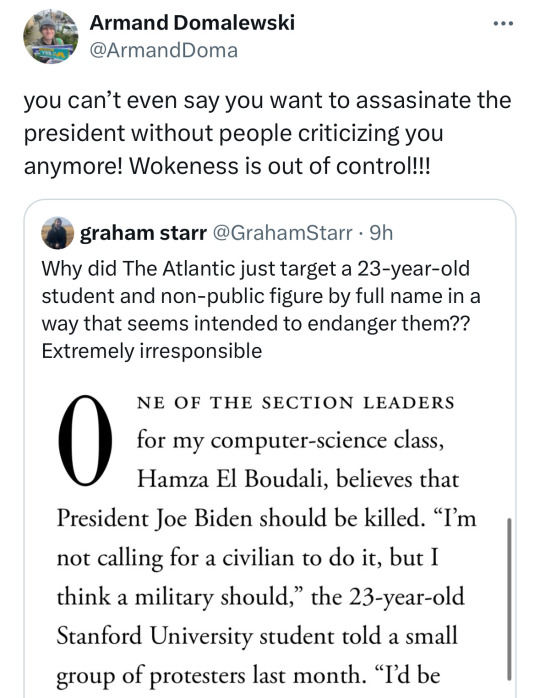
new 20-something minor just dropped
784 notes
·
View notes
Photo



Hamza El Boudali reflects on his past experiences at Stanford through a series of three images with a caption for each.
"This is me, a Moroccan, trying to blend in with Egyptians
"Father-son bonding"
“Meeting my long lost twin"
- Stanford c/o 2022
0 notes